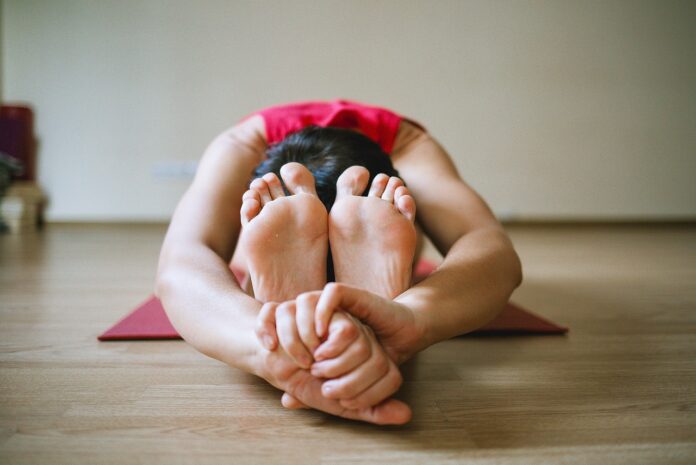
Regular stretching at home often gets overlooked, but it holds an assortment of benefits for both the body and the mind. Whether it’s to start your day off on a positive note or to unwind after a long day, a few minutes of stretching can make a significant difference.
The Importance of Stretching
Stretching is often associated with workouts, but its benefits extend beyond the exercise realm. Regular stretching at home can significantly improve your physical health, aid relaxation, and enhance your overall well-being.
Physical Benefits
When we consider the act of stretching, it’s easy to relate it to improved flexibility. However, this practice offers more than just an increased range of motion. Regular stretching assists in muscle recovery, reducing muscle soreness and helping you avoid injury.
Further, regular stretching can enhance posture by aligning your bones and joints, which can consequently alleviate back pain and discomfort. It also promotes better circulation, enabling blood to flow smoothly throughout your body, nourishing your muscles, and eliminating waste by-products in muscle tissue.
Mental Benefits
On top of the physical gains, stretching provides mental benefits as well. It’s a great tool for stress relief, as it can calm the mind, provide a mental break, and give your body a chance to recharge. During stretching, the focus shifts to your body and the present moment, promoting mindfulness, which is an effective technique to combat daily stress and anxiety.
How to Incorporate Stretching into Your Routine
With a basic understanding of the potential benefits, you might be wondering how to integrate regular stretching into your daily routine at home. It doesn’t require a significant time investment; even a few minutes a day can provide noticeable benefits.
When to Stretch
You can stretch at any time of the day, depending on your schedule and needs. Morning stretching can provide a great start to the day, helping to wake up your body. In contrast, evening stretching can help to release the tension accumulated throughout the day and prepare your body for restful sleep.
Making Use of Resources
Today, an abundance of resources can guide you through effective stretching routines, from books to stretch videos. The latter provides an excellent visual guide, making it easier to follow along and ensure proper form. Just be sure to approach any new routine gradually to avoid potential injury.
Stretching Techniques
Having highlighted the significance of regular stretching, let’s look into a few techniques that are easy to perform and can be incorporated into a daily routine at home.
Static Stretching
This type of stretching involves holding a stretch in a comfortable position for a period, typically between 15 to 60 seconds. It’s a great way to increase flexibility and relax your muscles. Some examples of static stretches include the butterfly stretch for your inner thighs and the triceps stretch for your arms.
Dynamic Stretching
Unlike static stretching, dynamic stretching involves movement. It’s an excellent method to prepare your muscles for physical activity, making it a beneficial warm-up before exercising. Leg swings, arm circles, and lunges with a twist are all forms of dynamic stretching.
Proprioceptive Neuromuscular Facilitation (PNF) Stretching
PNF stretching is an advanced form of flexibility training that involves both the stretching and contraction of the muscle group targeted. It’s often performed with a partner and is an excellent way to enhance athletic performance and rehabilitation.
Safety Considerations While Stretching
As with any physical activity, safety should be a prime consideration when stretching. Following a few key guidelines can help prevent any unwanted injury.
Warm-Up
It’s essential to warm up your body before stretching. A light warm-up increases blood flow to the muscles, preparing them for stretching and reducing the risk of injury. This could be a quick walk or light cardio activity.
Proper Technique
Ensure to use the correct technique when stretching. Improper form can lead to strain or injury. If you’re unsure, refer to trusted sources or consult with a physical therapist or trained professional.
Listen to Your Body
Each individual’s flexibility and tolerance levels are different. Stretching should create a mild tension in your muscles, but it should never cause pain. If it does, it’s an indication that you’re pushing too hard. Listen to your body’s signals and modify your stretching routine accordingly.
Making Stretching a Habit
Establishing a new habit can be a tricky task. However, with a little planning and consistency, regular stretching can easily become part of your daily routine.
Consistency
The key to any successful habit is consistency. Rather than doing a long stretching session once in a while, aim for shorter, regular stretches. Even just a few minutes a day can lead to improvements over time.
Make it Enjoyable
Find a way to make your stretching routine enjoyable. You could listen to your favorite music, stretch in a quiet, peaceful part of your house, or even stretch while watching TV. The more pleasant the experience, the more likely you are to stick to the routine.
Set Clear Goals
Finally, setting clear, realistic goals can be a significant motivating factor. Whether you’re aiming to improve your posture, reduce muscle tension, or simply dedicate a few minutes each day to self-care, having a clear objective in mind can help you stay focused and committed.
Conclusion
Stretching is an activity that demands little yet yields a lot. The key is to make it a regular part of your life. So, why not embrace this simple practice and discover its multitude of benefits for yourself?










